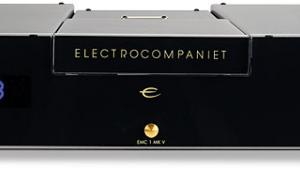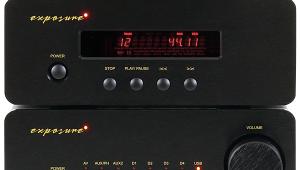Leema Stream (£1195)
Canny audio manufacturers never seem to run out of new takes on old formats. Because of such lateral thinking, the humble and now familiar CD has weathered (easily) a few dozen silver disc variations, up to and including SACD and DVD-A, which achieved minimal market penetration. Leema’s equivalent of CD Viagra is to add so many DACs that you have to marvel not at the technological achievement, but at the price: the updated Stream still sells for under £1200.
As the company puts it, ‘Sixteen 24-bit/192kHz multi-bit Delta-Sigma converters are used in Leema’s unique MD2 Active Differential Multi-DAC to produce an incredibly real and tactile musical performance with almost no noise and distortion.’ [See boxout, below.] And it is such a sweet-sounding player that you’ll find it hard to resist removing the cover to see if they slipped in a valve output stage.
L-DRIVER
Just as noteworthy, though, is the physical side of things, the deliciously refreshing take on ergonomics. I fell in love with L-Drive, the truly intuitive single rotary control for all functions. Without even opening the owner’s manual, I knew how to use it to skip tracks, pause, open the tray – everything bar track programming. It is minimalism with a purpose, not minimalism for the hell of it. And while there is a teensy remote control for those who don’t want to get out of their seats and walk over to the player, L-Drive is such fun that the remote might gather dust.
If L-Drive seems like a psychological leap, you’ll also have to accept a display that shows only the track number or a heavily-abbreviated code for the functions. Although this unit is full-sized at 435x90x330mm (whd), Leema chose not to clutter it with an LCD. Is this for cost savings? A Bauhaus fetish within the Leema ranks? I don’t know, but neither do I care, as I have long been used to minimalist track information thanks to an in-car player that shows the track number only. If you need more, Leema’s Antila will do nicely.
For owners of other Leema components, the Stream also features LIPS (Leema Intelligent Protocol System). This enables Leema products to communicate with each other, such that a single press of the L-Drive control, for example, will select play, switch on the amp and select the CD input. You just gotta love it. Especially if you’re a lazy sod such as I.
And before you think you’ve read all this before, the Stream has recently enjoyed an upgrade, Leema feeling that ‘recent new product developments have led to a significant upgrade by replacing surface mount components with hand-matched, high-grade audiophile parts in key areas of the player.’ The Stream’s performance has been substantially improved, with distortion reduced by a significant margin at high treble frequencies. Leema attributes to this ‘a much blacker background, finer high frequency detail and better spatial awareness.’
BACK TO BLACK
This is one of those products that not only possesses an instant sonic likeability, but also goes on giving. I tried it side-by-side with my reference at this price – Quad’s CDP99 II – and the Leema matched it for silkiness, while displaying wider dynamics and, as promised, a much ‘blacker background’. In the more sparse passages in the Creedence Clearwater Revival canon, courtesy of the newly-remastered CDs, the acoustic guitars possessed a wonderful woodiness, fingers could be heard sliding past frets. And the vocals...
With Fogerty’s distinct nasality a key determinant of the CCR sound, it was chilling to hear how the Leema swung from high peals to occasional gutturals with swift facility: this player should come packed with a copy of Cosmo’s Factory. When you get to the rich bass of ‘I Heard It Through the Grapevine’, backed by some sizzling and tactile cymbals, with wonderfully cheap-sounding trap drums, you’ll have to remind yourself that this was recorded for AM radio. Via the re-worked Stream, it possesses a fat majesty, almost Stax-like (rather than Motown). This CD player simply adores textured percussion.
Where the Quad (and Musical Fidelity’s much dearer kW25) challenged the Leema were in the areas of three-dimensionality and bass attack. Both created a much larger soundstage, especially the stage width, and by some margin. Both, for example, placed coherent sounds beyond the edges of LS3/5As and Sonus faber loudspeakers, while the Stream stopped precisely at the edges of their respective baffles. Front-to-back depth was nearly identical, though, and image height left very little to criticise.
LITTLE DEVIL
Regarding the attack, the Leema is one fast little devil, and listening to some rapid plucking from Rory Gallagher showed the unit’s way with proper leading edge transients and realistic decay. Conversely, the lower octaves had sublime mass and speed, but the attack was more precise with the Quad. This phenomenon was less noticeable with drums – the latest bouts of the Move and Led Zep remastering had enough mass and force to satisfy the current club crowd – but I’ve heard tighter electric bass guitar and synth. Listen to the Cars’ first album, a showcase for this effect if ever I heard one.
But that’s a trivial complaint. This player simply caresses vocals, allowing voices as disparate as Peggy Lee and Alison Krauss to sound as real as it ever gets. The top-to-bottom coherence is joyously ‘of a whole’, even with my minor reservations about the bass. This is a silky-sounding player, with high-end appeal but a refreshingly sane price tag.
VERDICT
Competition is hot in this sector, what with every British brand seeming to have something credible between £800-£1500. Leema adds the sort of technical overkill that says so much more than metaphysical mumbo-jumbo – eg strange wires, odd feet – that you actually feel you’re getting a bargain. And for me, there’s added charm: L-drive and the lack of a display make this stand out from the crowd. Bravo!
Originally published in the January 2009 issue

























































